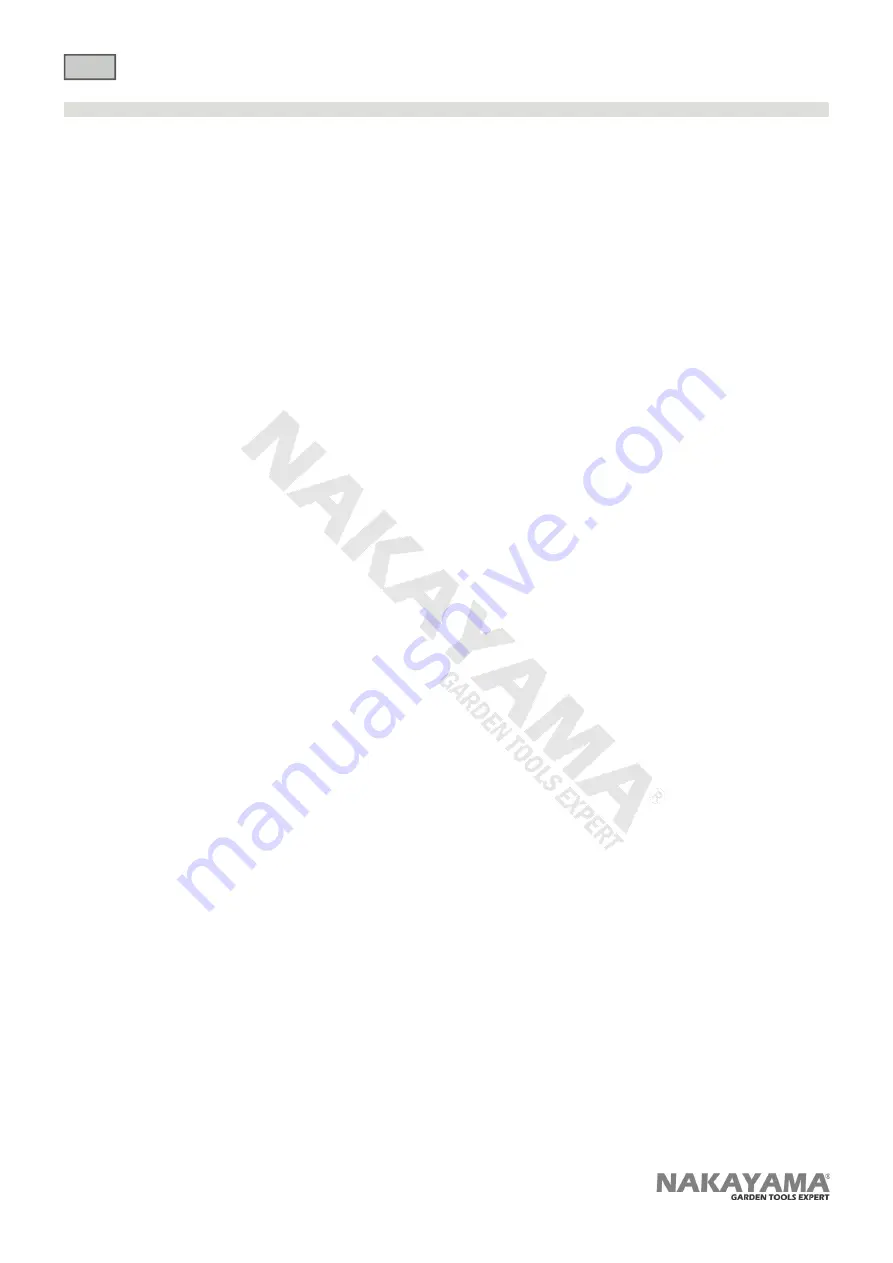
EN
WWW.NAKAYAMATOOLS.COM
8
Before the use
Unpacking
1. Unpack all parts and lay them on a flat, stable surface.
2. Remove all packing materials and shipping devices if applicable.
3. Make sure the delivery contents are complete and free of any damage. If you find that parts are missing or show damage do not use the product but contact
your store. Using an incomplete or damaged product represents a hazard to people and property.
4. Ensure that you have all the accessories and tools needed for assembly and operation. This also includes suitable personal protective equipment.
Chain tensioning check
WARNING!
Unplug the product from the power source before adjusting the saw chain tension! The cutting edges of the saw chain are sharp. Always wear
protective gloves when handling the chain!
NOTE:
The chain and bar have been already assembled on the machine when you get it out of box. If disassembled chain and bar for replacement, please read
the maintenance part in this manual for details.
Always maintain proper chain tension! A loose chain increases the risk of kickback! A loose chain may jump out of the guide bar groove! This may injure the
operator and damage the chain! A loose chain will cause rapid wear to the chain, guide bar and sprocket!
Tensioning the chain too tightly will overload the motor and cause damage, and insufficient tension can cause chain derailing, whereas a correctly tightened
chain provides the best cutting characteristics and prolonged working life! The chain life mainly depends upon sufficient lubrication and correct tensioning!
Saw chain tensioning is required first. Check the chain tension using one hand to lift the saw chain (2) against the weight of the product. The correct chain
tension is achieved when the saw chain can be lifted by approximately 2-4mm from the guide bar (1) in the center (Figs. B, C).
WARNING!
Always disconnect the mains plug before performing any checks or adjustments.
Always wear protective gloves when working on the pole saw to protect yourself against injury.
If loose chain is found before use, please follow up the instruction below.
(If tight chain is found before use, please do the opposite to the below instruction.)
Firstly Set the product on a suitable flat surface and remove the guard of guide bar (16).
Then slightly tighten the grey Knob (4) clockwise. (Fig. D)
Do not tighten the grey Knob (4) completely in a way that another grey Knob (3) around the grey knob (4) can be tightened clockwise for chain tensioning.
When the chain tension is appropriate, keep tightening the grey Knob (4) completely.
Saw Chain Tensioning
Always check the saw chain tension before use, after first cuts and regularly during use approximately every five cuts. After initial operation, new chains can
lengthen considerably.
This is normal during the break-in period and the interval between future adjustments will lengthen quickly.
Important! All of the chain links must lie properly in the guide groove of the cutter rail.
NOTE: After operating the product for approximately 1 hour, adjust the chain tension again.
Lubrication
WARNING!
The product is not filled with oil. It is essential to fill the product with oil before using it! Never operate the product without chain oil or with an
empty oil tank, as this will result in extensive damage to the product!
Never operate the bar and chain without lubrication oil!
Operating the products dry or with too little oil will decrease cutting efficiency, shorten the product life span and cause rapid wear to the chain and bar from
overheating! Insufficient oil is evident by smoke or bar discolouration! Adequate lubrication of the saw chain during cutting operations is essential to minimize
friction with the guide bar. Your product is equipment with an automatic oiling system! The oiling system automatically delivers the proper amount of oil to
the bar and chain!
Set the product on any suitable surface with the tank cap (5) facing upwards.
Unscrew and remove the tank cap (5), then add the lubricant into the tank. Use a proper funnel with a filter to prevent debris entering the tank and to avoid
spilling and overfill and leave approx. 5mm of space to the lower edge to allow the lubrication to expand (Fig. E).
Check the oil level window (Fig. F) prior to start-up and regularly during operation. Refill oil when the oil level is lower than “MIN” marking (Fig. F).
Wipe up spilled lubricant with a soft cloth and refit the tank cap (5).
NOTE:
Always dispose of lubricant, used oil and objects contaminated with them in accordance with local regulations.
Connection to the power supply
Picture G: (1) Cable hook
WARNING! For your safety, it is required that the plug attached to this product is always connected to an extension cable when cable is insufficient to your use!
The extension cable must be suitable for outdoor use with sockets protected against water splashing! Ensure the extension cable is of the proper size and type
for your product!
The extension cable must always be used with the cable strain relief! Do not use the product without an extension cable connected. Always use a residual
current supply (RCD) protected supply!
Make sure the on-off switch (13) is in its off position.
Double the extension cable, about a foot from the end and hook the loop over the cable strain relief. Gently pull on the cord to ensure that it is firmly attached
at the handle (Fig. G).
Connect the extension cable to a suitable socket.
Your product is now ready to be used.
WARNING! Check the voltage! The voltage must comply with the information on the rating label!





































